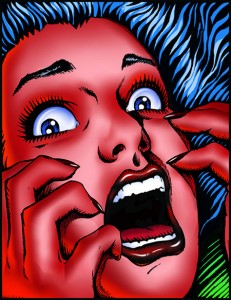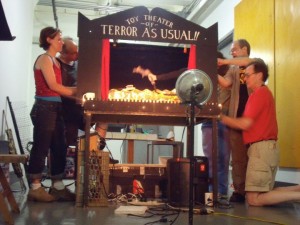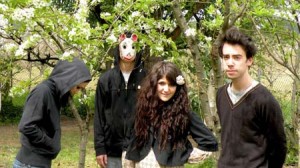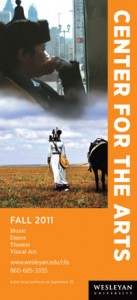Students in Professor Ellen Nerenberg’s Advanced Italian class (ITAL221) interviewed the company members of Dewey Dell soon after they arrived on campus. The students then translated the interviews into English, so that members of our campus and community can get to know them better. Enjoy!
Eugenio Resta
Interview by Chelsea Reutcke, Class of 2012, Advanced Italian I
This weekend I sat down to talk with Eugenio Resta, of the avant-garde Italian theatre group Dewey Dell. The quartet consisting of Eugenio and Agata, Teodora and Demetrio Castellucci was first formed at a rhythmic movement and philosophy school in Cesena in 2007. Teodora gathered the group together to put on a small performance. Now they have five shows in their repertory and tour Europe. The group’s visit to Wesleyan is also its premiere in the United States. Eugenio commented on the excitement of performing to an audience made up largely of students, saying how rare an occurrence that would be in Europe. Each member plays a specific role in the group and Eugenio’s task is to design and oversee the lighting and scenery. Although he studied set design in Urbino, Italy, he has had no formal training in lighting and has learned as he goes along. The type of sets and lighting required vary from one show to another, ranging from simple to complex designs, depending on the mood he tries to invoke. If a problem concerning the set or lights arises during a show, Eugenio says he tries to stay level-headed and calm as he works through the issue, and the show continues on. The individual performances always vary though, so company members don’t get bored, he joked. He also explained that Dewey Dell members strive to always be astonished by their work. As far as any specific lessons he wants imparted on the audience, he said “Niente,” nothing. He wants the public to see something they had never seen before, a new world far from their own, and to take away an emotion that they felt while watching the performance.
Interview by Alana Rodriguez, Class of 2013, Advanced Italian I
Following study at the Stoa in the city of Cesena, Italy, the avant-garde theater group named Dewey Dell has been performing since 2007. They have performed in different European countries and now, for the first time, in the United States here at Wesleyan. Within Dewey Dell, Eugenio Resta is responsible for the shows’ set and lighting design. He has various sources of inspiration including movement, and when designing a set attempts to create the environment. He also utilizes special effects, such as smoke and lasers, to visually enhance the scene for the audience. The other group members-Agata, Demetrio, and Teodora Castelluci-are siblings and he enjoys working with them and helping them with other tasks involved in creating a show for performance. For the audiences here at Wesleyan, who are mostly university students, he wants to create a world that doesn’t exist and that evokes many emotions. He likes classical genres in theater and design that is very imaginative since, according to him, there are ample sources of inspiration for one idea in theater. In addition to Dewey Dell, Eugenio studies and works other kinds of jobs. Yet for him, Dewey Dell is not just a job, but a passion.
Agata Castellucci
Interview by Grace Asleson, Class of 2013, Advanced Italian I
Last Saturday (September 10), I had the opportunity to meet with Agata Castellucci, a twenty-year-old actress, choreographer dancer, and member of the experimental theater group, Dewey Dell, which she helped to found with her sister, brother, and another friend. When I met Agata, I didn’t know what to expect—she is my age and has already traveled the world. She has not only established a career in the performing arts, but has also co-created her own group. Oh and did I mention that this is all while she continues to study at the University of Milan? Needless to say, I was intimidated.
But, as I found out, she is not only down to earth, but she was also great fun and happily attended a local concert with my friends and I on Friday night. When I asked Agata about Dewey Dell, she told me that the name was inspired by a character in William Faulkner’s novel As I Lay Dying. From this name, and support from her artist parents, Agata and the rest of Dewey Dell have created something potent, eerie, and totally unexpected. Friday night’s performance was an explosion of energy and talent with elaborate costumes and sharp staccato movements.
Soon into our interview, it became apparent that Agata is an old soul—she began to travel with Dewey Dell while still in high school, learning about different cultures, which in turn fuel her ideas. But Agata, in many ways, felt like she could be a peer and a friend. She admitted that the siblings do not always agree on choreography, but sometimes the disagreements spark greater creativity. I look forward to seeing more of Agata’s style and grace at Dewey Dell’s final performance this weekend, Cinquanta Urlanti
Quaranta Ruggenti Sessanta Stridenti, to be performed in the CFA Theater on Friday, September 16 at 8pm.
Interview by Isabella Cucchi, Class of 2013, Advanced Italian I
It was incredibly enlightening to speak with Agata Castellucci about her past in theater, her roles within Dewey Dell, and her impressions of both Italian and American culture. Agata explained that her passion for choreography and theater began at a young age. Because their parents own a well-established, internationally renowned theater company in Italy, Agata and her siblings were constantly exposed to the arts, and cultivated an appreciation for theater from an early age. This ultimately led to the Castelluccis’ desire for and decision to create a niche for themselves, separate from their parents’ sphere of influence. (According to Agata, the group decided on the name Dewey Dell for the simple reason that the four members happened coincidentally to be reading Faulkner’s As I Lay Dying at the same time.) While sibling rivalry can sometimes hinder their artistic process, Agata reported that the group generally gets along well, and that each member contributes something unique and important. As the youngest member of Dewey Dell, Agata is inspired by her older siblings. At one point in the interview, she fondly described her household growing up as “never silent,” with music booming constantly from her brothers’ rooms. This, she explained, offered yet another source of appreciation for the arts, and specifically for artistic diversity. Agata explained that she now listens to everything from classical music to electronic dance music to rock and roll, and all of these genres affect the group’s work. Dewey Dell did not achieve immediate success, however. Agata noted that her professors at school did not initially approve of the movement, and group members were forced to make excuses for occasionally missing class or turning in a late assignment. Since overcoming these scholastic obstacles, Dewey Dell has traveled the world, exploring different universities, groups, and cultures. Agata remarked that she loves America, noting its differences from Italy, and especially from her small town of Cesena. She, like all the Dewey Dell members, is very happy to explore Wesleyan and all it has to offer. She is particularly excited to have the experience of working with her own age group in pursuit of something she loves.
Teodora Castellucci
Interview by Sydney Lowe, Class of 2013, Advanced Italian I
The first time I met Teodora, she wasn’t wearing much makeup—just a t-shirt and jeans along with a bright smile. I was slightly embarrassed by my newly-remembered Italian (tenses and vocabulary which I lost over the long summer), but was excited at the opportunity to get to know this rising international star. Born in the small town of Cesena, Italy, at 23, Teodora is already an incredibly accomplished dancer, choreographer, costume designer and founding member of the avant-garde performance group Dewey Dell. With her co-company members, she has performed around the world (Barcelona, London, Berlin, and Italy, to name a few venues). Even though she never formally studied dance, she says that to be a dancer has been her dream since she was a young girl.. In 2007, her dream became a “family-affair” reality when she started working with her equally talented siblings Agata and Demetrio, and their close friend Eugenio Resta. à elle vide is an avant-garde performance piece that revolves around the curious void between a rooster (Teodora) and a scorpion (Agata). The second piece that will be performed at Wesleyan on September 16, Cinquanta Urlanti Quaranta Ruggenti Sessanta Stridenti, is about the blurred borders between sailors, the ship, the wind and the sea. Teodora says that although their performances have no specific objective, they want the audience to try to understand their movements without using words—to have their eyes talk for them the way Dewey Dell Bundren in Faulkner’s book As I Lay Dying does. (The group’s name, Dewey Dell, is a tribute to one of Teodora’s favorite authors, the strange yet captivating Faulkner.) When I attended their performance later that night that was exactly what I saw. The Teodora on stage seemed to be a completely different person from the young woman I’d talked to in the middle of Usdan only hours earlier. It is clear that Teodora speaks with her precise movements, her bold red makeup, the music and more; more than just her eyes. “People always tell you, ‘Yes, go follow your dream!’ It seems very cliché. But now, I am actually following my dream and, honestly, it couldn’t be better.”
Interview by Edgar Pliaskis, Class of 2014, Advanced Italian I
The contrasting colors of the posters of Dewey Dell around Wesleyan campus attract the attention of many. And although everyone has a chance to see the fantastic performances of this experimental theater group Dewey Dell, I got a chance to meet and chat with one of the performers, Teodora Castellucci.
As we slowly assembled a conversation, I learned that generally, two different animals such as a cat and a scorpion influence each performance. This influence is usually gets reflected through the costumes that Teodora designs herself (seen on the posters.) Theodora noted that Dewey Dell does not have a real mission. Rather, it wishes the audience to perceive the movements of the choreography and build their own interpretation.
This group has performed multiple times throughout the members’ native Italy as well as in London, Paris, Barcelona and just recently the United States. I urge everyone to show up to at least one of the performances that Dewey Dell has put together for us to enjoy.
Demetrio Castellucci
Interview by Rosie Keogh, Class of 2013, Advanced Italian I
The Wesleyan community is thrilled to have the avant-garde Italian theatre group Dewey Dell on campus. Demetrio Castelucci, co-founder of the group, and its musical engineer, is enthusiastic to see Wesleyan students’ response. The music for the two productions– à elle vide, and Cinquantana Urlanti Quaranta Ruggenti Sessanta—is largely electronic. The experimental, non-verbal sound reflects the company’s muse: Dewey Dell Bundren in William Faulkner’s As I Lay Dying. Dewey Dell, one of the novel’s stream of consciousness narrators, is nearly mute. The Dewey Dell production, correspondingly, uses expressive non-verbal music and visual onomatopoeia to relate to its audience. The music employs both computer technology and an electronic orchestra. The internationally traveled group hopes to return to Wesleyan with a student workshop on campus sometime before this December.
Dewey Dell: Cinquanta Urlanti
Quaranta Ruggenti Sessanta Stridenti
United States Premiere
Friday, September 16, 2011 at 8pm
CFA Theater
$18 general public; $15 senior citizens, Wesleyan faculty/staff, non-Wesleyan students; $6 Wesleyan students
Dewey Dell is an event in Outside the Box, a series of groundbreaking performances and discussions in theater, co-sponsored by the Theater Department and Center for the Arts.








